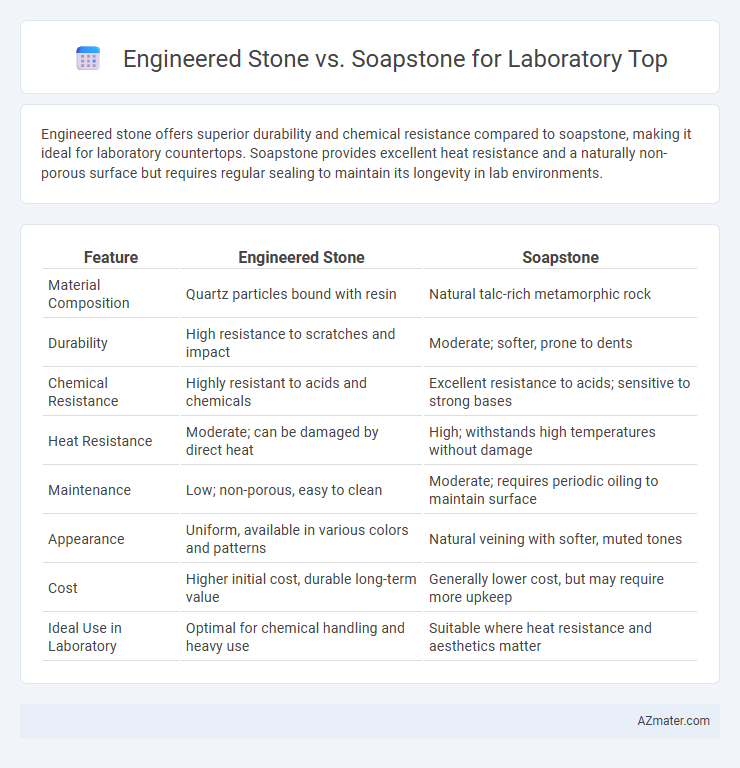Engineered stone offers superior durability and chemical resistance compared to soapstone, making it ideal for laboratory countertops. Soapstone provides excellent heat resistance and a naturally non-porous surface but requires regular sealing to maintain its longevity in lab environments.
Table of Comparison
| Feature | Engineered Stone | Soapstone |
|---|---|---|
| Material Composition | Quartz particles bound with resin | Natural talc-rich metamorphic rock |
| Durability | High resistance to scratches and impact | Moderate; softer, prone to dents |
| Chemical Resistance | Highly resistant to acids and chemicals | Excellent resistance to acids; sensitive to strong bases |
| Heat Resistance | Moderate; can be damaged by direct heat | High; withstands high temperatures without damage |
| Maintenance | Low; non-porous, easy to clean | Moderate; requires periodic oiling to maintain surface |
| Appearance | Uniform, available in various colors and patterns | Natural veining with softer, muted tones |
| Cost | Higher initial cost, durable long-term value | Generally lower cost, but may require more upkeep |
| Ideal Use in Laboratory | Optimal for chemical handling and heavy use | Suitable where heat resistance and aesthetics matter |
Introduction: Engineered Stone vs Soapstone for Laboratory Tops
Engineered stone offers superior durability and resistance to stains and chemicals, making it ideal for demanding laboratory environments. Soapstone provides excellent heat resistance and natural non-porous properties, ensuring chemical stability and ease of maintenance in lab settings. Both materials are favored for laboratory tops due to their unique strengths in durability, chemical resistance, and surface maintenance.
Material Composition and Properties
Engineered stone for laboratory tops is primarily composed of crushed quartz bound with polymer resins, offering exceptional durability, non-porosity, and resistance to stains, chemicals, and scratches. Soapstone, a natural metamorphic rock mainly made of talc and magnesium silicate, is inherently heat-resistant, non-porous, and chemically stable but softer and more prone to scratches than engineered stone. The engineered stone's uniform surface and higher hardness make it ideal for demanding lab environments, whereas soapstone's thermal stability and resistance to acids suit specific applications requiring natural stone characteristics.
Chemical Resistance Comparison
Engineered stone offers superior chemical resistance due to its non-porous surface, making it highly resistant to acids, alkalis, and solvents commonly found in laboratory environments. Soapstone, while naturally dense and less porous than many other natural stones, can be susceptible to staining and etching from prolonged exposure to strong chemicals. Choosing engineered stone ensures enhanced durability and easier maintenance when exposed to aggressive laboratory chemicals.
Durability and Longevity
Engineered stone offers superior durability and resistance to scratches, stains, and chemicals due to its non-porous composition made from quartz and resins, making it ideal for demanding laboratory environments. Soapstone, a natural stone composed mainly of talc and magnesium silicate, is heat-resistant and chemically inert but softer and more prone to scratching and wear over time compared to engineered stone. Engineered stone's enhanced longevity and low maintenance requirements provide a more resilient laboratory top surface, whereas soapstone may require periodic sealing and careful handling to maintain its integrity.
Maintenance and Cleaning Requirements
Engineered stone laboratory tops offer low-maintenance benefits due to their non-porous surfaces, resisting stains and requiring only mild soap and water for cleaning. Soapstone, while naturally resistant to chemicals and heat, demands regular oiling to maintain its finish and prevent surface drying or discoloration. Both materials provide durable options, but engineered stone's ease of cleaning and minimal upkeep make it preferable for high-traffic laboratory environments.
Aesthetic and Design Flexibility
Engineered stone offers a wide range of color options and consistent patterns, making it ideal for customized laboratory tops that require precise aesthetic coordination. Soapstone features a natural, matte finish with subtle veining that develops a unique patina over time, enhancing its organic appeal in laboratory design. While engineered stone provides greater design flexibility with uniformity and vibrant hues, soapstone excels in delivering timeless elegance and a softer, more tactile surface.
Installation Process and Costs
Engineered stone countertops require professional installation due to their heavy weight and precise cutting needs, with costs typically ranging from $50 to $100 per square foot, including labor. Soapstone installation is less complex and can sometimes be handled by skilled DIYers, but professional installation averages around $70 to $90 per square foot because of its dense nature and need for careful sealing. Both materials demand solid substructure support, but engineered stone often involves higher upfront installation expenses compared to soapstone due to its fabrication requirements.
Environmental Impact and Sustainability
Engineered stone countertops typically consist of quartz and resin, which involve energy-intensive manufacturing processes and the use of non-renewable materials, making their environmental impact higher. Soapstone, a natural material formed over millions of years, requires minimal processing and emits fewer pollutants, offering a more sustainable choice for laboratory tops. Selecting soapstone supports reduced carbon footprint and enhances long-term durability, aligning with eco-friendly laboratory design goals.
Safety Considerations in Lab Environments
Engineered stone offers high resistance to chemicals and scratches, making it suitable for laboratory tops where durability and hygiene are critical; however, it may release silica dust during fabrication, posing respiratory risks that require proper ventilation and protective equipment. Soapstone is naturally non-porous and highly resistant to acids and heat, enhancing chemical safety and reducing contamination risks, but it can be softer and more prone to scratching, which may impact long-term durability in rigorous lab use. Selecting between engineered stone and soapstone for lab environments hinges on balancing chemical resistance, durability, and the safety protocols necessary during installation and maintenance.
Conclusion: Choosing the Right Material for Laboratory Tops
Engineered stone offers superior durability, resistance to stains, and customizable design options ideal for high-traffic laboratory environments requiring chemical resistance and easy maintenance. Soapstone provides natural heat resistance and excellent chemical inertness, making it suitable for laboratories prioritizing thermal shock resistance and a traditional aesthetic. Selecting the right material depends on specific laboratory needs such as chemical exposure, durability demands, and maintenance preferences.

Infographic: Engineered stone vs Soapstone for Laboratory Top
 azmater.com
azmater.com